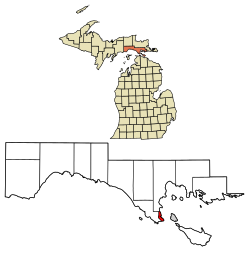St. Ignace, Michigan
| St. Ignace, Michigan | |
|---|---|
| City | |

Downtown St. Ignace
|
|
 Location of St. Ignace, Michigan |
|
| Location of St. Ignace, Michigan | |
| Coordinates: 45°51′57″N 84°43′33″W / 45.86583°N 84.72583°WCoordinates: 45°51′57″N 84°43′33″W / 45.86583°N 84.72583°W | |
| Country | United States |
| State | Michigan |
| County | Mackinac |
| Area | |
| • Total | 2.69 sq mi (6.97 km2) |
| • Land | 2.68 sq mi (6.94 km2) |
| • Water | 0.01 sq mi (0.03 km2) |
| Elevation | 587 ft (179 m) |
| Population (2010) | |
| • Total | 2,452 |
| • Estimate (2012) | 2,452 |
| • Density | 914.9/sq mi (353.2/km2) |
| Time zone | Eastern (EST) (UTC-5) |
| • Summer (DST) | EDT (UTC-4) |
| FIPS code | 26-70840 |
| GNIS feature ID | 1621477 |
Saint Ignace, usually written as St. Ignace, is a city at the southern tip of the Upper Peninsula of the U.S. state of Michigan, bordering the Straits of Mackinac. The population was 2,452 at the 2010 census. It is the county seat of Mackinac County. For travelers coming from the Lower Peninsula, St. Ignace is the gateway to the northern part of the state.
St. Ignace Township is located just to the north of the city, but is politically independent.
Located in Michigan's Upper Peninsula, St. Ignace is at the northern end of the Mackinac Bridge and Mackinaw City is the southern end. The bridge connects the Lower and the Upper peninsulas of Michigan.
As of the 2010 census, nearly one-third of the population of the city identified as Native American. The Mackinac Bands of Chippewa and Ottawa Indians, a state recognized tribe, is headquartered at St. Ignace, and has bands in several other counties in the region. In addition, the large federally recognized Sault Ste. Marie Tribe of Chippewa Indians owns and operates a casino on its land in St. Ignace, as well as in four other cities in northern Michigan.
St. Ignace is the second-oldest city founded by Europeans in Michigan. Before French contact, various cultures of Native Americans had inhabited the area for thousands of years. Early historic peoples here were predominantly the Iroquoian-speaking Wendat, whom the French called the Huron.
...
Wikipedia

